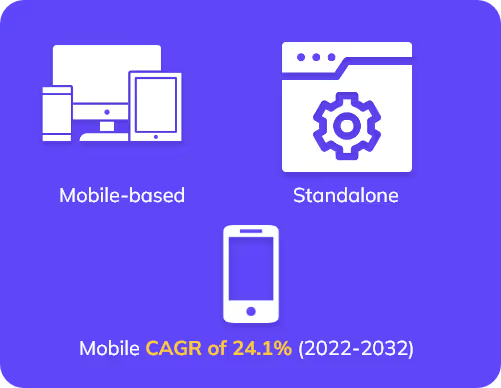This whitepaper explores the crucial role of AI chatbots in mobile platforms, highlighting their impact on customer engagement, support, and sales. It also explains the benefits of mobile commerce, including improved customer satisfaction, quicker response times, and better scalability, offering valuable insights for businesses looking to leverage chatbot technology.

Customer engagement involves companies interacting with customers through multiple channels to build strong relationships. Enterprises do this through social media, community forums, email, and more where customers communicate. Considering the digitalization of various organizations, customer engagement is a top priority these days. Such engagement is being made possible by going mobile with regard to all applications, services, and outreach.
Enterprises aim to integrate sales, marketing, support, and product to deliver seamless, personalized experiences for the customers they cater to. Let us explore how a mobile-first approach powered by chatbots leads to higher customer engagement.

The end of 2021 saw a staggering 67% of the world population (5.3 Billion people) subscribed to mobile services. Such mobile services and technologies generated a massive GDP (Gross Domestic Product) value of 5% globally, which amounts to $4.5 trillion.
Mobile networks are the only form of internet connectivity across significant areas around the world, more than 200 million people connected to the internet for the first time in 2021. This figure will expand to another 800 million people by 2025.Globally the capital expenditure undertaken by mobile operators will cross $600 billion worldwide from 2022 to 2025. Approximately 85% of this CAPEX will be invested in 5G network and related infrastructure.
The saying goes that some people live out of a suitcase, meaning they carry their essentials with them to wherever they go. In the age of digitalization, people live out of their mobile devices, carrying their world with them wherever they go. What does that mean in terms of consumer behavior? It means that mobile shopping trends are on the rise, along with communicating with brands on the go.

North America is forecasted to have the biggest slice of the chatbot market at US$ 2.8 Bn. Considering the growth rate, APAC is expected to grow the fastest, as the countries in this region are on top of technological trends.
Expansion in the chatbot market in the APAC region is more likely considering the flexible economic conditions and government policies towards digitalization. Startups in the AsiaPacific region have continued to invest heavily in AI/ML technology that will accelerate chatbot development.
To keep pace with competitors, small and medium-sized organizations are incorporating chatbots as part of customer service automation efforts. Rising economies such as India and China have a thriving smartphone market that makes space for chatbot customers.

By PlatConsidering the platform as a criterion, mobile is the segment that is leading with a forecasted CAGR of 24.1% (2022-2032).
Since various mobile applications that use AI for chatbots or image analysis are increasing in frequency and usage, it holds a larger market share for the forecasted period.

Since larger enterprises are investing in the latest technologies to boost revenue and efficiency, chatbot adoption has increased considerably. Continuous customer service and minimized marketing expenditures are part of the reason why chatbot adoption has gone up.
Such a trend will continue during the forecast period, leading large enterprises to have a significant CAGR of 21%.

Slush is a not-for-profit company that sponsors events to bring together potential founders and creators at their events. Their latest event, held in Helsinki in 2022, had 20,000 people in attendance and needed responsive customer service with high availability.
Slush used the chatbot builder JennyBot by the GetJenny enterprise to automate over 67% of customer service chats, answer FAQs, and free up event staff from repetitive tasks. With the event staff having their time freed up, they could concentrate on more crucial tasks that could not be automated. In the end, Slush handled over 55% more conversations than the previous year. The chatbot solution, in this case, would be accessed mostly on mobile platforms.

Bestseller is a clothing and accessories MNC that includes brands from Vera Moda and Jack & Jones to ONLY. The challenge here is to cater to the needs of 17,000 global employees spanning 40 countries with a large customer base. These numbers translate to high volumes of customer queries across various media platforms, from social channels to websites.
Customer requests needed to be resolved around the clock, reliably, and consistently. Bestseller used Heyday by Hootsuite to manage incoming customer requests. Their custom multilingual solution responded in French or English across the company’s Facebook Messenger channel and the Canada e-commerce website.
This way, Bestseller’s custom messenger chatbot solution enabled their team to focus on tasks that required a human touch. Meanwhile, a majority of the customers had timely access to FAQs.

HLC is a major bicycle parts manufacturer based out of the USA, with a presence in Canada. HLC website had around 1000 customers logging in daily, raising the need for FAQ automation, which led them to turn to Acquire Live Chat. The FAQ chatbot took over repetitive queries, freeing up the internal team to handle more complex tasks. As the internal team did not have to handle repetitive queries, they could dedicate their time to live chat. The results, as expected, were quite significant, with over a 100% live chat response rate and a simpler onboarding for new hires. HLC also benefitted from enhanced visibility into the product and business issues.

Customer requests spiked heavily post the start of the pandemic, with people choosing to order fitness products and sporting equipment as fitness centers and gyms closed down. Decathlon UK who were already using Hootsuite’s Heyday chatbot solution, ramped up their use of the chatbot to yield amazing results. They introduced a feature that enabled agents to curate personalized shopping carts and share the same via DM. This offers a personal touch to the whole-commerce experience that makes the customer feel valued. This was coupled with helpful automated product suggestions and related customer care services, which boosted sales.
The results were staggering, to say the least, with:
96% of customers described themselves as being very satisfied with the service after implementing the AI-enhanced Messenger experience. The digital assistant implemented through Messenger also generated a 175% spike in customers who reached out to Decathlon UK through this channel
There was also a 55% increase in query volumes that was resolved through automated means, that in turn led to a 25% increase in agent productivity. This change was in the first six months of introducing automation.

Babylon Health is a digital-first health service provider that combines an artificial intelligence-powered platform with virtual clinical operations for patients. Patients are connected with health care professionals through its web and mobile applications.
Babylon Health seeks to address challenges to healthcare access through its mobile application, which connects users to healthcare services while preserving valuable healthcare resources. The app thus reduces the need for users to travel from remote locations—or to come out of self-isolation during the COVID-19 pandemic—to see a doctor.
“It is time to change the way we’ve been delivering healthcare. It is possible to do so when organizations like AWS make the cloud so widely available—to mobile networks, to the technology companies out there that have provided so much of the infrastructure we need,” says Dr. Ali Parsa, CEO, and founder of Babylon Health.

The 3rd Quarter of 2022 saw Android users offered a choice between 3.55 million mobile applications on the Google Play Store. The Apple App Store was a close second, offering its users around 1.6 million mobile applications for the iOS platform. Even with a regular filtration of low quality applications from their app stores, the number of apps has been increasing steadily over the years.

Mobile applications, while useful to companies to connect with customers, also generate revenue on their own. The three main ways that applications generate revenue include:
Regarding the monetization of mobile applications and content, the Apple App store leads with an impressive $21.5 Billion, with the Google Play Store bringing in 12.1 Billion worldwide. This means Apple is doing a better job of monetization mobile applications and content, with users spending more, even though the application count is significantly lesser.
What these numbers mean for mobile applications in the future is more opportunity in the mobile space for innovators and disruptors. Mobile-friendly Enterprises and willing to go the extra mile for their customers are bound to thrive in a mobile-first market.

Mobile commerce (m-commerce) includes all electronic commerce and sales executed through mobile devices such as smartphones and tablets. There are three aspects of m-commerce, including shopping, banking, and payments. It is a part of e-commerce which is a broader and older concept that includes desktops and laptops as well. Mobile commerce has the advantage of using push notifications, working without the internet (POS transactions), and using location-based tracking and services. The global m-commerce payment market value was $7,345.24 billion in 2020 and is forecasted to touch $33,153.13 billion by 2030. This will be made possible with a CAGR of 16.5% from 2021 to 2030. Market drivers for m-commerce include reduced transaction time and resulting convenience for consumers.
With regard to the mobile payment aspect of m-commerce, India is the fastest-growing and most established market with its unique ecosystem of online payments. The growth of India’s mobile payments is largely due to the United Payments Interface (UPI). UPI is a digital payment gateway known to be simple and centralized, depending on any single bank. This is built on a robust and secure IMPS system.
There are also certain challenges to the market for mobile payments that, include increases in data breaches and geo-location payment preferences that prove expensive.

The pandemic increased the time spent by users on mobile devices, acting as a major driver for small businesses to go in for mobile applications. This would directly translate to more interaction and engagement with their consumers.
In a survey conducted by Top Design Firms, the number of small businesses that have a mobile application has increased from 32% in 2021 to 48% in 2022. Also, it was found that the percentage of small-sized enterprises that don't plan to release a mobile application has halved since 2021 to 13% from the earlier 26%.
Small businesses seem to support Android and iOS applications in equal proportions, as seen in the image below.

According to Bigcommerce, over 80% of customers are ready to pay higher rates for a better experience. This statistic points to the fact that product or price alone does not decide how a consumer chooses a brand today but views the customer experience as a whole to make an informed decision. A positive customer experience will directly translate to higher conversion and retention rates for businesses. This is where conversational commerce comes in that is also known as conversational marketing or chat commerce. Conversation commerce refers to a conversational experience delivered to a potential customer through a chatbot, voice assistant, messaging platform, or even a chat app. To qualify as a conversational experience, customer communication should be personalized and helpful while moving the customer through the sales funnel.
The global conversational commerce market is forecasted to grow at a significant CAGR of 15.6% from 2022 to 2032. The market is expected to touch a value of $ 26,301.8 Million by 2032, while the current valuation as of 2022 stands at $ 6,147.1 Million.
Mobile integration is a process of connecting different applications and devices to gain seamless data exchange and optimized workflows. Through mobile integration, consumers can access a wide range of applications on all their devices, and businesses can enhance the efficiency of their business processes.
With the right mobile integration, you can transform your smartphone into a seamless communication device that uses messaging, voice calling, call routing, reporting, and file-sharing capabilities.

Android devices come in multiple screen sizes with varying pixel densities and different OS. This kind of device fragmentation increases the development complexity of the Android app platform. Apple, on the other hand, releases a limited number of devices, leaving them with limited screen variables to program for.
Android developers will have to account for more than just graphics, with developers using multiple devices to test applications that need to be displayed with similar experiences for all devices. This will require testing and development that involve
Kommunicate’s no-code chatbot solution comes with a developer-friendly installation for all your platforms that is speedy, secure, and scalable for enterprises of every size. Here are some reasons why Kommunicate is leading the way with mobile chatbot integrations:

Kommunicate is a customer support automation platform based out of Delaware, USA looking to transform customer support automation through chatbots. Our bot solution allows your business to communicate with your customers across several channels. It enables you to build AI-powered chatbots, record and track leads, and generate FAQs to improve client self-service.
It also connects to CRM and e-commerce systems, among other things, allowing for data interchange. It can also route talks to the appropriate agent and automatically detect dormant chats to improve productivity. To make the most of all client interactions, Kommunicate provides comprehensive messaging templates. You may use Kommunicate to integrate chat widgets into your apps and to install the platform on your website. The company has been awarded the 'Rising Star Company' and 'Great User Experience Award' , showing how our clients trust us to bridge the gap between your customers and business.